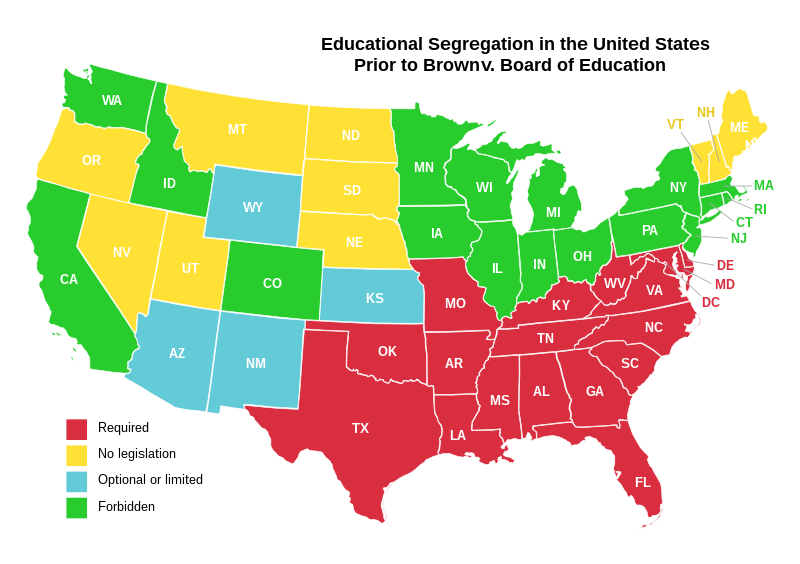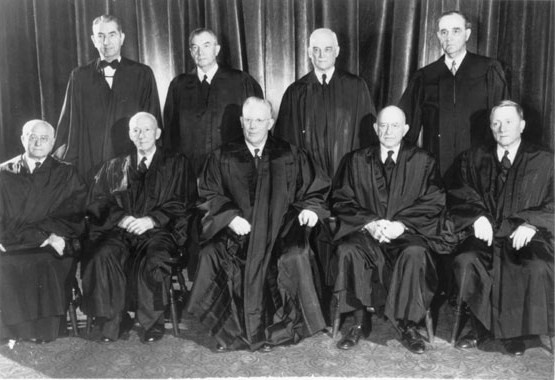In 1954, the
United States Supreme Court declared that “separate, but equal” was no longer
constitutional in the United States, overturning Plessy v. Ferguson, and idealistically forcing an equal society for
the first time in U.S. history. The problem? That’s not quite what the decision
said.
Let’s
begin with the background—what lawyers refer to as “the facts of the case.” Thirteen
parents of Topeka, Kansas, public school students filed a class action to force
the district to reverse its policy of racial segregation. The plaintiffs lost
in the district court because, even though the court found that segregation in
public education had a detrimental effect on African-American children, the
schools were substantially equal with respect to buildings, transportation,
curricula, and education. By the time the case went to the Supreme Court, it
had been consolidated with five other cases representative of five other
states, all of which were sponsored by the NAACP. Fun fact: the lead attorney
on this case was Thurgood Marshall.
Things
went differently in the Supreme Court. First, the Court didn’t decide the case
in its first hearing. It asked for a second argument a year after to focus
specifically on the issues raised by the Equal Protection Clause. Second,
before that subsequent hearing, one of the very conservative justices died—to be replaced by Earl Warren, the architect of the single most liberal
Supreme Court in this nation’s history. Thus, in a sixteen page per curiam decision (per curiam being fancy Latin for a
unanimous court), the Court struck down racial segregation. The holding was
quite literally that segregated black and white schools of equal quality were
still harmful to black students, and therefore had to be unconstitutional under
the Equal Protection Clause.
The Warren Court
But
that is where this gets really
interesting. Two points: first, the Supreme Court relied on social science for
the first time in making this decision. The Court pointed to psychology and
other social science studies about the effect of segregation of the
African-American psyche. This was an unprecedented step. To that date, the
Supreme Court had based its decision in legal precedent and statutory
interpretation. To go beyond that, one might argue, was more akin to creating legislation,
rather than judging the law. And as we all know, the power to legislate rests
only with Congress. Second, and most importantly, the Supreme Court did not
automatically end segregation. Contrary to popular belief, Brown told the states to change “with all deliberate speed.” What
does all deliberate speed mean?” No one
really knows.
In
the end, it took a second decision for the Court to delegate orders that
desegregation occur. And it’s taken repeated litigation efforts to get the
Court to not only reaffirm its commitment to what has become affirmative
action, but also to make communities respect the mandate. The Supreme Court has
had to repeatedly decide cases about how schools should be run; how they should
treat their students; how busing routes should be driven; and
more. This may seem like what the Supreme Court is supposed to do, but let’s
remember the contours of the actual decision: was Brown meant to go that far? Or should Congress have stepped in and
done the actual governing? Should the individual state communities have created
their school standards? Should the Court have reviewed them on appeal, rather
than created the guidelines that individual communities then had to wrestle
with?
All these answers depend on your view of the Court’s role in our constitutional
structure. But at the end of the day, only the right to equality exists in the
Constitution. Separate but equal is unconstitutional. And so, perhaps, is a
Court that legislates from the bench.
By Laura Ferguson


No comments:
Post a Comment